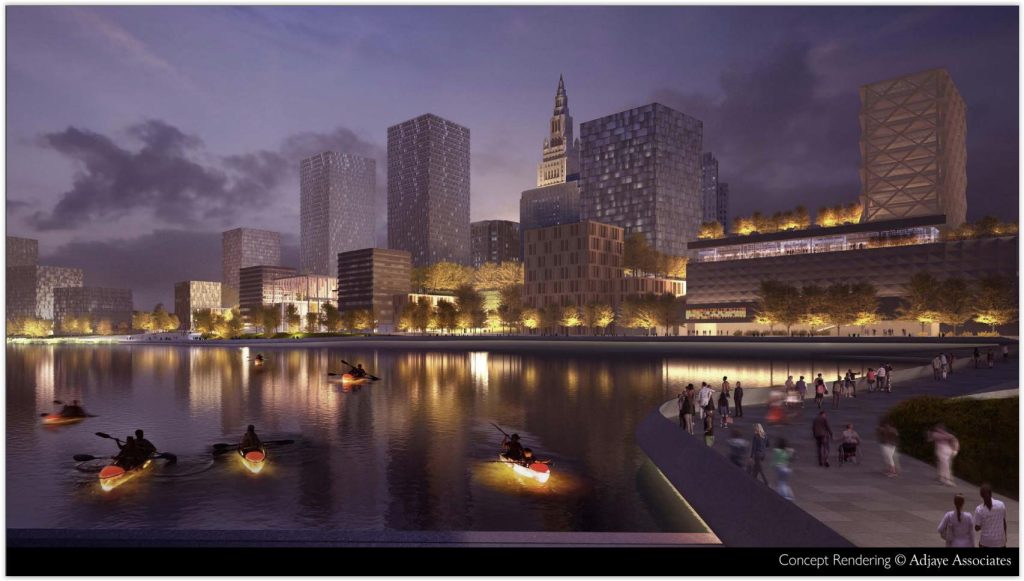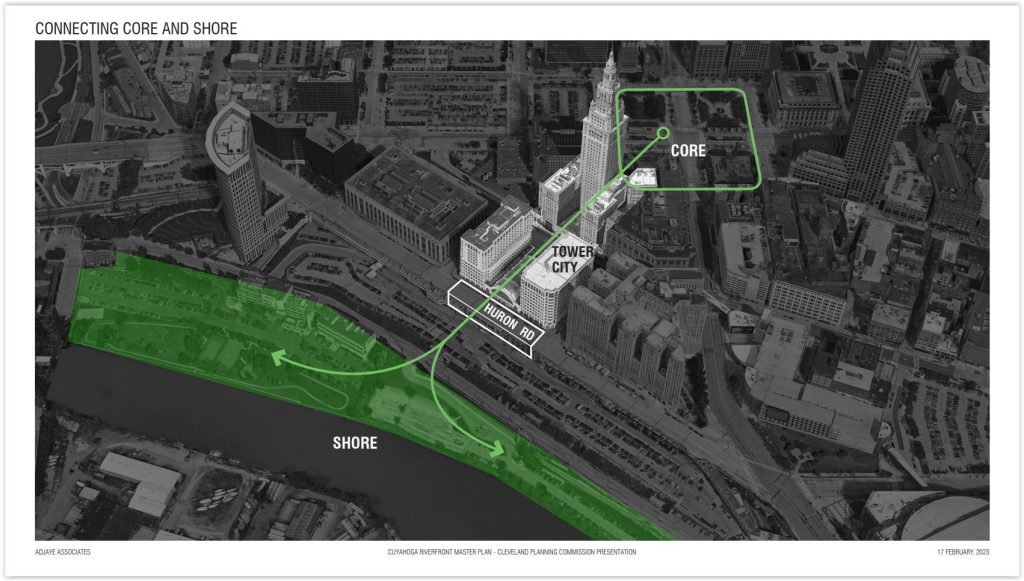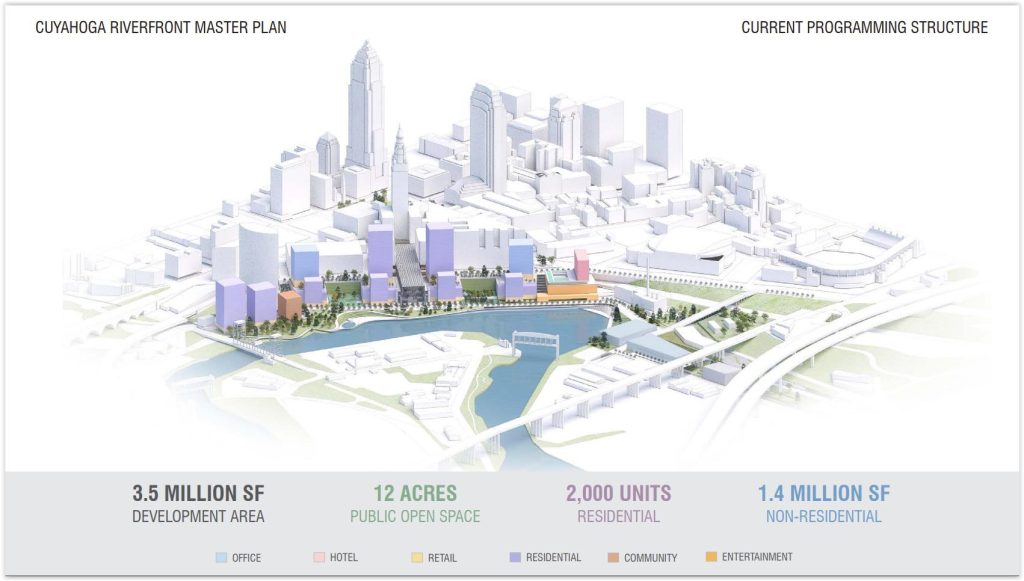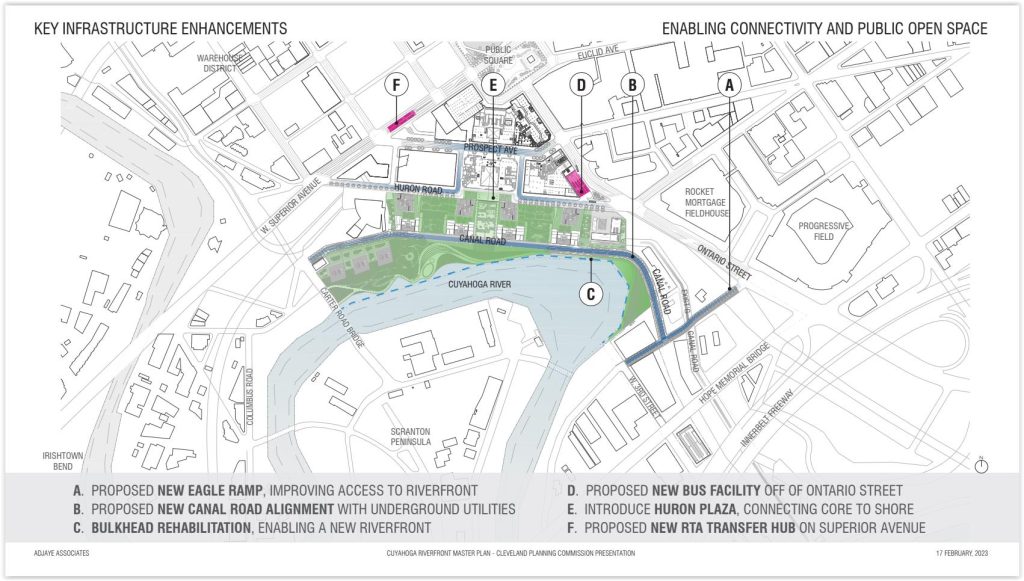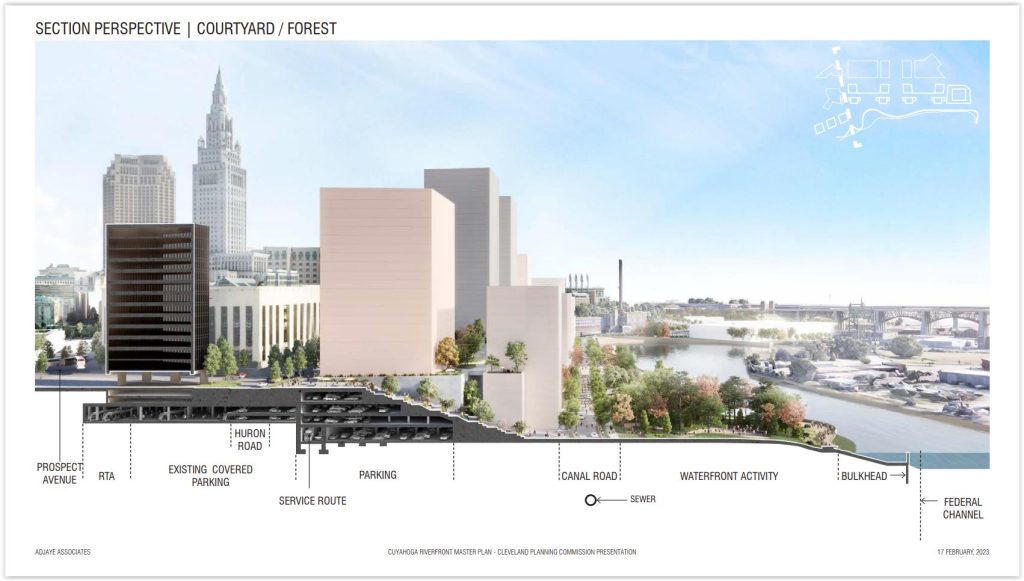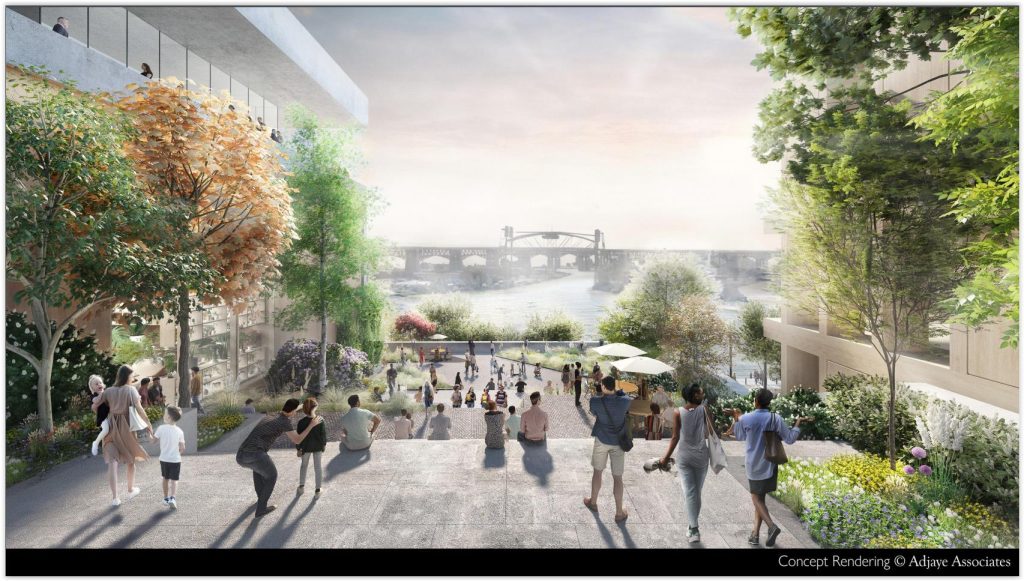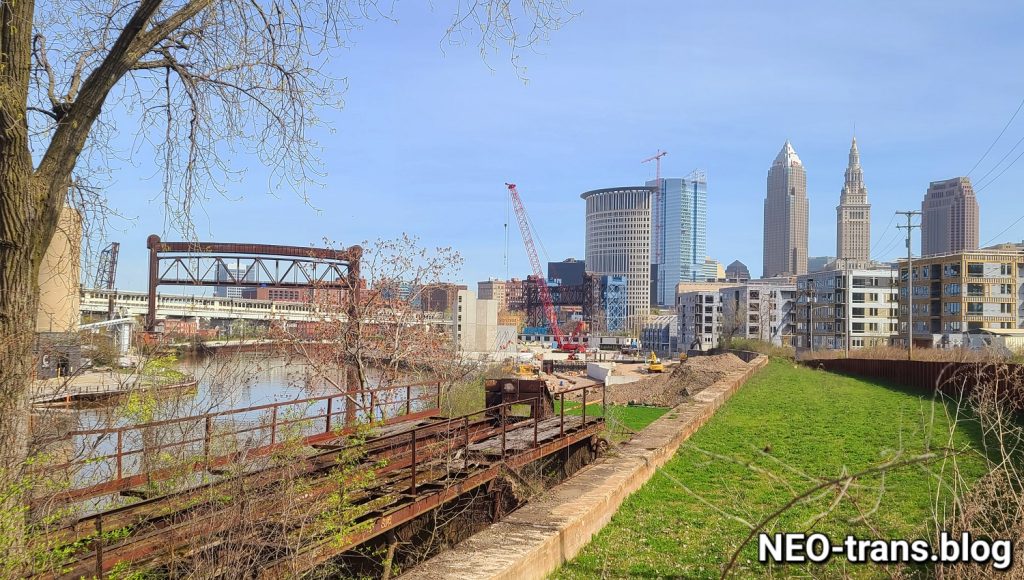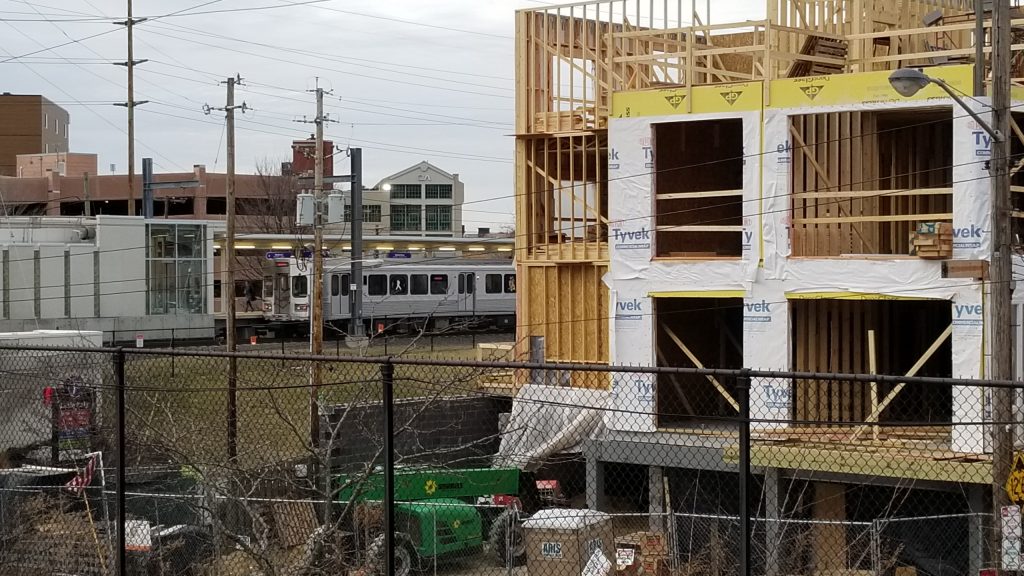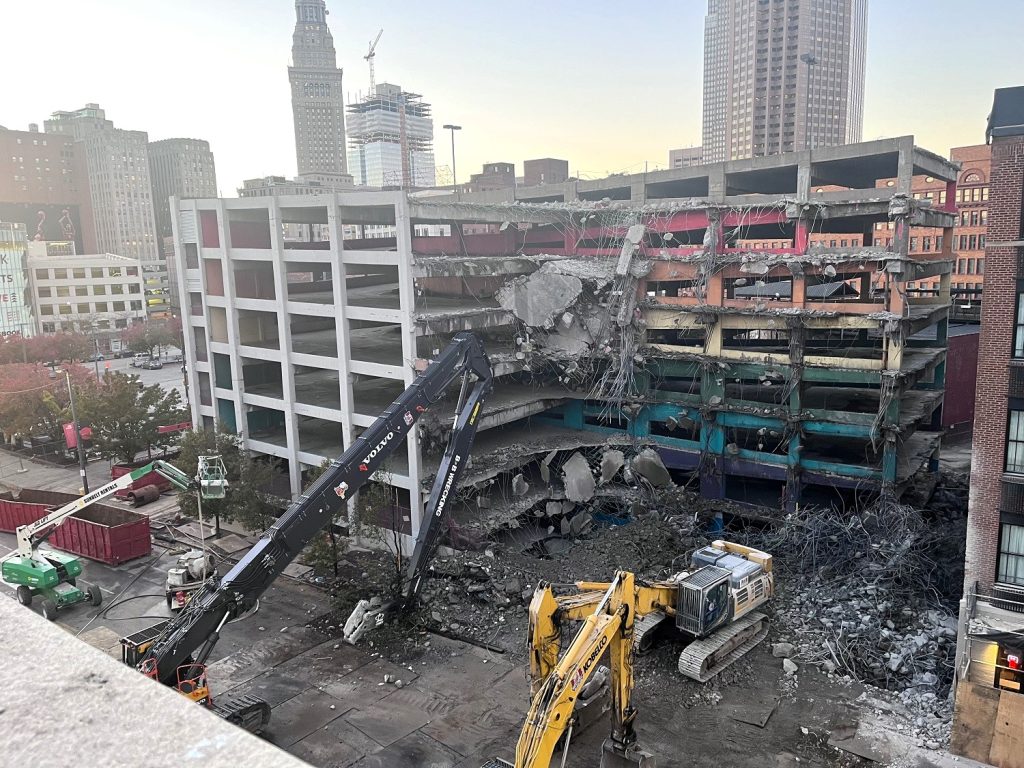Public meetings, infrastructure improvements ID’d
At the City Planning Commission’s design-review meeting starting 9 a.m. Friday, representatives of Detroit-based Bedrock are scheduled to present more of its vision for downtown Cleveland’s riverfront below Tower City Center. In addition to showing renderings of the buildings and public spaces, Bedrock’s architectural team led by Adjaye Associates will lay out a schedule and a menu of items needed for building the infrastructural foundations to support the ambitious riverfront plan.
Significant public dollars will be needed to afford that infrastructure but a price tag for them is not yet available. In the coming weeks, Bedrock’s design team intends to hold public engagement meetings starting with this week’s Planning Commission meeting. They also plan to hold meetings on the city’s near-East Side and near-West Side although details are soon to be posted. This article will be updated if those details are provided on or before this Friday.
In the spring, Bedrock wants city approval for its riverfront master plan, to finalize a master development agreement with the city and its project partners and get it approved by City Council before the end of the year. The city and Bedrock had begun discussing a development agreement going back to when Bedrock first let it be known publicly of its interest in downtown’s riverfront in September 2021.
In early December, Bedrock’s architects released more detailed images of their 20-year vision for the portion of the Cuyahoga Riverfront that’s closest to Public Square — the geographic heart of the city more than 200 years. That $3.5 billion vision includes 2,000 residential units equaling roughly 2 million square feet of new space, plus another 1.4 million square feet in non-residential structures including 850,000 square feet of office space, a boutique hotel, retail and entertainment uses.
According to sources familiar with Bedrock’s intentions, the first three structures are likely to include an office building with Rocket Mortgage as an anchor, a high-rise apartment building, and a boutique hotel, possibly the Shinola flag, built atop an “entertainment facility.” That entertainment facility could legally be a casino. State law allows a casino to be built at that location.
But Bedrock’s development footprint for downtown Cleveland got even bigger last month when it acquired more than 3 acres of mostly vacant land from Stark Enterprises in the neighboring Gateway District. That site can be developed more quickly than the riverfront site because it needs fewer infrastructure improvements and time may be of the essence for Bedrock to build a new office building for its large Rocket Mortgage offices here in downtown Cleveland. Rocket Mortgage’s lease at the Higbee Building expires at the end of 2026. But a source who spoke off the record this week said that the most recent plans he saw for the Gateway site were relying heavily on multi-family.
The riverfront infrastructure improvements Bedrock will discuss in its presentation to the city later this week include:
• Proposed new Eagle Avenue ramp, improving access to riverfront
• Proposed new Canal Road alignment with underground utilities
• Bulkhead rehabilitation, enabling a new riverfront
• Proposed new bus facility off of Ontario Street
• Introduce Huron Plaza, connecting Core-To-Shore
• Proposed new RTA transfer hub on Superior Avenue
To achieve that, Bedrock’s design and development team said they will need to complete their traffic impact assessment of the proposed roadway changes and multi-modal access. The latter could also involve adding bus transfer facilities on West Superior Avenue and Ontario Street, where multiple routes of the Greater Cleveland Regional Transit Authority converge.
And, while not shown on Bedrock’s diagrams, sources familiar with a proposed extension of the Cuyahoga Valley Scenic Railroad from the Cuyahoga Valley National Park’s northern terminus in suburban Independence to downtown said Bedrock was interested in the idea. The discussions reportedly involve running the trains north on the former Baltimore & Ohio Railroad tracks to the vacant but preserved historic B&O depot at Canal and Carter roads. That is the subject of planning work by the Northeast Ohio Areawide Coordinating Agency and would require running the trains through Bedrock’s riverfront development site.
Rehabilitation of the riverfront bulkhead refers to strengthening or replacing a steel retaining wall along the banks of the Cuyahoga River to prevent erosion and preserve a minimum 24-foot draft or depth for large commercial ships. To do that requires time-consuming permitting through the U.S. Army of Corps of Engineers. For large buildings to be built next to the river will likely require additional strengthening of the bulkhead.
Plans also show reopening the Eagle Avenue ramp. It was open from 1930-2005, connecting Ontario Street via a lift bridge over the river to Scranton Peninsula with a ramp to Stones Levee where additional redevelopment is happening. But those concrete, elevated ramp structures decayed over time and, in the mid-2000s, the city didn’t have the money to rebuild the Eagle Avenue ramp.
It was closed and its elevated concrete ramps ultimately demolished, although the lift bridge superstructure remains over the river with the roadway deck in a permanently raised position. Bedrock’s plans show that the Eagle ramp would be reopened only as far as West 3rd Street. It would not involve reactivating the lift bridge over the Cuyahoga River. For comparison, the city spent $32 million to rehabilitate the similar Columbus Road lift bridge a decade ago.
Furthermore, Bedrock’s design team would like to realign Canal Road which has a large sewer line beneath it so as to be able to better fit buildings on the riverfront, including through Sherwin-Williams’ Breen Technology Center site. Bedrock has a purchase agreement for the 9-acre research center property as well as for the global coatings company’s 93-year-old headquarters building at 101. W. Prospect Ave. Sherwin-Williams is relocating its research center to suburban Brecksville and moving its headquarters to the west side of downtown’s Public Square.
The aging headquarters may be repurposed with housing amid Prospect and Huron which may also be repurposed but for pedestrians and community functions. The Huron Plaza mentioned above is part of that vision, as well as the desire for the Core-To-Shore pathway that would link Public Square to the river, which is the nearest waterfront.
Both Huron and Prospect are actually bridges between Ontario and Superior — once built above Cleveland Union Terminal facilities including tracks, platforms, baggage areas, and the station’s main concourse. Although Greater Cleveland Regional Transit Authority trains continue to use the terminal, the larger part of the station stopped serving mainline railroads in 1977 and was repurposed as Tower City Center by Forest City Enterprises a dozen years later.
END

